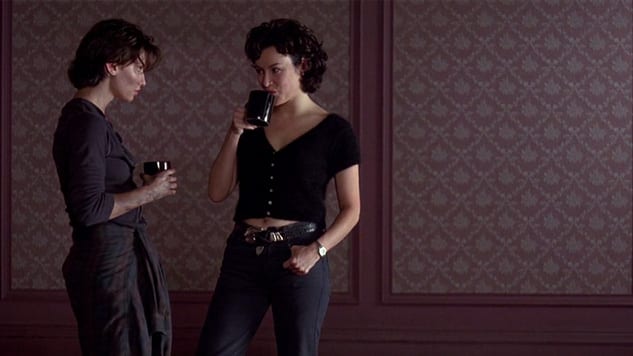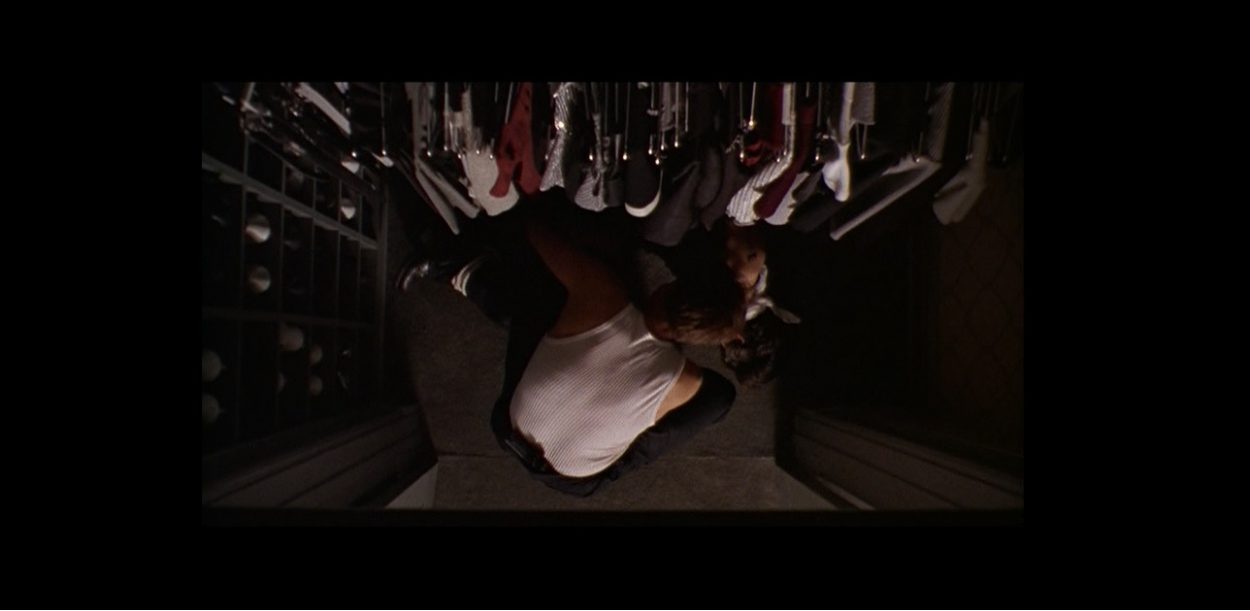If, like me, you’re a fan of film noir you are most likely familiar with questions such as: What are the consequences of not fitting in? and, What happens when your world is so unrecognizable, so inhuman that you cannot possibly fit in?
If you judge film noir by the emphasis on uncertainty and how to navigate a difficult and often unknowable world, Bound is worth looking at. The Wachowski’s 1996 neo-noir gangster thriller stars Gina Gershon as Corky, an ex-con who has been hired by to restore an apartment. One day on the elevator, she locks eyes with Violet (Jennifer Tilly), the girlfriend of a mafioso wiseguy named Ceasar (Joe Pantoliano) and before long Corky and Violet involved in a passionate sexual affair. Violet asks for Corky’s help in getting out of her life attached to the mob and stealing two million dollars while they’re at it.
Bound has often been overlooked for the Wachowski’s more popular films—The Matrix, V for Vendetta—which, in my opinion, is even more of a reason to look back at the refreshing new take on the complex relationship between a traditional family and an individual who does not belong.
The film reorients the perception of women and queer individuals in relationship to traditional (albeit dysfunctional) family structures, portraying that fluidity, individuality, and acceptance leads to self-fulfillment and success, while living by the traditional—and often patriarchal—rules and ideals lead to dejection and ultimate self-destruction. The Wachowskis thread this concept into the fabric of the movie, where Tilly and Gershon are quite literally bound; to each other, to their perception in society, to the powerful men who control their lives and bound by their own ideas about what intimacy, sexuality ad divergence means for them.
Queerness, the ultimate form of deviance, is seen as a threat to traditional family structures, just as in traditional film noir the femme fatale is seen as a threat to men, their families, and the ‘natural order’ of western society. The prototype of the femme fatale has been historically and culturally regarded as deviant and immoral. Bound twists this perception by instead replacing the femme fatale’s threat to the traditional structure with a clear picture of the violence and oppression that a ‘traditional’ family structure inflicts on individuals who do not belong to its structure. The movie accentuates this severity and violence towards divergent individuals by substituting the more traditional family for the mafia.

The Wachowskis make clear that violence is not always physical, it can often be psychological. The dehumanization of Violet is showcased through her treatment by the various men of this ‘family’. Because Violet is distinctly feminine, Caesar enjoys using her to boast about the fulfillment of his sexual needs, essentially boasting of his ownership of her in front of the family as validation for his masculinity. This also holds true for the rest of the men in the family, as she is continuously belittled—not once called by her name but rather called “pet”, “doll” or “puppet”—flirting with her in front of Caesar in attempts to compete with him and prove their own masculinities. Through this abasement, Violet is dehumanized and used a phallic symbol, as in this family she is simply an object of desire and never an equal.
Like most oppressive patriarchal units, the mafia has strict rules and hierarchies which punish those who threaten or do not abide by its rules. The head of the family, the older man, must always be in power. In their first meeting, Caesar—wiseguy white Italian mobster—gives Corky money, binding her to him and attempting to overpower her and keep her in check, a not so subtle “welcome to the family”. However, since the beginning, Corky never once compromises her individuality, as the opening scene depicts her bound and gagged by Ceasar inside of a dark wardrobe. Once Caesar realizes Corky does not comply with his rules he must ensure her submission by the means he recognizes; he beats her, disgusted that the “stupid dyke” is threatening his ownership of Violet and thus his masculinity and supremacy. Caesar locks her in his wardrobe—a space symbolic for its repression of sexuality—and proceeds to bound and gag her in the color of female purity and meekness: white. Forcing the queer individual which he cannot control into a repressive male space—as the closet is full of predominantly male clothes—showcases the homophobia and fear that toxically masculine men have of deviant women, and of the threat that they pose to their hierarchy.

Corky and Violet’s relationship, however, has the exact opposite dynamic than that of the mafia. Both women have been in binding situations for five years; Corky in jail and Violet in her oppressive relationship with Caesar. They start a relationship, a figurative and metaphorical separation from the repressive systems they are bound to. It is only once they start this relationship that they are free at last from oppressive rules and gender roles. Violet wears pants and smokes and Corky has no problem letting Violet be—quite literally—on top. Corky continues painting the apartment white, just as she and Violet hide their relationship under a cover of innocence. The two women are free to transgress labels and expectations that were previously set upon them.
Their approach to sexuality is severed from the traditional family structure as well, as the two women reach sexual gratification devoid of any conservative heterosexual methods, opting instead to use their hands. The hands become a symbol of pleasure as well as a symbol of power and individuality, as it shows that there can be pleasure and self-fulfillment away from the rules and binds of the standard hierarchy. When Ceasar realizes this, he threatens Violet with cutting off her fingers, which is a torture device on the surface but is driven by a much deeper a homophobic drive to remove her queerness and her bond to Corky, just as he cut off Shelly’s fingers as a symbolic castration when he threatened the mafia. The loss of a finger, this metaphorical castration, would mean the loss of their sexuality, their individuality, and their empowerment.
Another excellent point of the Wachowski’s, however, is that Caesar himself is affected by the hierarchy he fights to protect. The pivotal scene of Ceasar drying and hanging the two million dollars to dry is reminiscent of a woman doing household chores. Caesar, too, has to cater to the men above him.

Violet and Corky, with their newfound trust in themselves and in each other, also decide to fight back against that which oppresses them. Exploiting the fact that these men do not believe that Violet, the seemingly naive woman is capable of such an act, they steal the money and hide it in white paint, the symbol of their supposed innocence. While they are caught and taken hostage by Caesar, they are both individually able to save themselves; Corky herself escapes the closet and Violet shoots Caesar, the red of his blood splattering on the white paint showcasing Violet’s individuality finally appearing amid all of her supposed naivety and innocence.
It is indeed through acceptance of themselves and of their individuality, as well as their acceptance and trust in each other that Violet and Corky come out triumphant. Leaving all traces of the mafia behind, Corky ultimately abandons her own ‘toxic masculinity’. She discards her narrow definition of lesbianism in favor of Violet’s perspective, ditching the conventional obsession with power and ownership and instead opting to trust blindly and reach out to Violet even though the wall separates them.
As the plan finally unfolds in their favor and the pair is finally free, they do not depart as two Femme Fatales, as we see in traditional film noir, but simply as two women in love. The apartment is finished and painted in pristine white. This shot is very similar to that of Corky and Violet after they have first made love, laying in bed with a white sheet binding them together. Yet instead of purity or innocence, this white speaks of their own liberation; a clean slate, and a new beginning.




